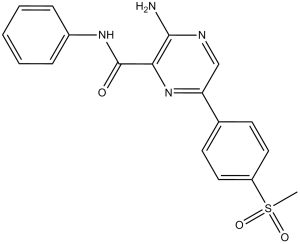This product is for research use only, not for human use. We do not sell to patients.

| Size | Price | Stock |
|---|---|---|
| 100mg | $450 | In Stock |
| 250mg | $700 | In Stock |
| 500mg | $1050 | In Stock |
Cat #: V2527 CAS #: 1232410-49-9 Purity ≥ 98%
Description: VE-821 is a novel potent and highly selective ATP competitive protein kinase inhibitor of ATR (ataxia telangiectasia mutated and Rad3 related) with Ki and IC50 of 13 nM and 26 nM in cell-free assays, it shows inhibition of H2AX phosphorylation, and had minimal activity against PIKKs ATM, DNA-PK, mTOR and PI3Kγ.
Publications Citing InvivoChem Products
Product Promise

- Physicochemical and Storage Information
- Protocol
- Related Biological Data
- Stock Solution Preparation
- Quality Control Documentation
| Molecular Weight (MW) | 368.41 |
|---|---|
| Molecular Formula | C18H16N4O3S |
| CAS No. | 1232410-49-9 |
| Storage | -20℃ for 3 years in powder formr |
| -80℃ for 2 years in solvent | |
| Solubility In Vitro | DMSO: 74 mg/mL (200.9 mM)r |
| Water: <1 mg/mLr | |
| Ethanol: <1 mg/mL | |
| Solubility In Vivo | 30% PEG400+0.5% Tween80+5% propylene glycol: 30 mg/mL |
| Synonyms | VE-821; VE 821; VE821; Chemical Name: 3-amino-6-(4-(methylsulfonyl)phenyl)-N-phenylpyrazine-2-carboxamide SMILES Code: O=C(C1=NC(C2=CC=C(S(=O)(C)=O)C=C2)=CN=C1N)NC3=CC=CC=C3 |
| Protocol | In Vitro | VE-821 shows excellent selectivity for ATR with minimal cross-reactivity against the related PIKKs ATM, DNA-PK, mTOR and PI3Kγ (Kis of 16 μM, 2.2 μM, >1 μM and 3.9 μM, respectively) and against a large panel of unrelated protein kinases |
|---|
| Solvent volume to be added | Mass (the weight of a compound) | |||
|---|---|---|---|---|
| Mother liquor concentration | 1mg | 5mg | 10mg | 20mg |
| 1mM | 2.7144 mL | 13.5718 mL | 27.1437 mL | 54.2873 mL |
| 5mM | 0.5429 mL | 2.7144 mL | 5.4287 mL | 10.8575 mL |
| 10mM | 0.2714 mL | 1.3572 mL | 2.7144 mL | 5.4287 mL |
| 20mM | 0.1357 mL | 0.6786 mL | 1.3572 mL | 2.7144 mL |
This equation is commonly abbreviated as: C1 V1 = C2 V2
- (1) Please be sure that the solution is clear before the addition of next solvent. Dissolution methods like vortex, ultrasound or warming and heat may be used to aid dissolving.
- (2) Be sure to add the solvent(s) in order.




































